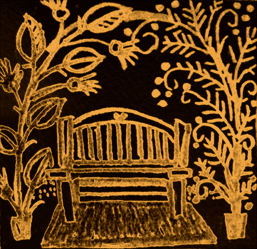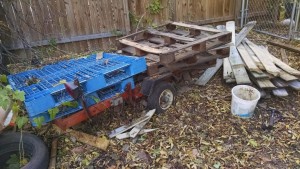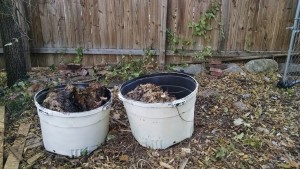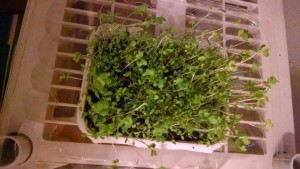Compost is one of the “vitamins” we offer our plants.
Compost can be made in a large bin (e.g., 4’x4’ pallets), a wire bin, a tomato cage lined with wire mesh, a trash can (DIY compost tumbler). The important thing is to keep the mix of brown and green, keep it moist (like a sponge) and keep it turned/aerated.
I wanted something smaller for my composting, something I could move about if needed. Since I had a number of containers used by landscapers to transport trees, I decided to repurpose them. They are a decent size – about 30” in diameter and about 18-20” deep. They also have drainage holes in the bottom.
I wanted them closer to the back door than the compost pile I had 25 years ago, because the easier the access, the more likely I am to deposit food waste into it. However….the spot was occupied by an old utility trailer covered with scavenged fence pickets. I spent the afternoon removing nails from the pickets and stacking them elsewhere.
A friend helped me to move the trailer out and the bins in.
Now, the bins already contained leaves from last fall, so I had a head start on the brown for my piles.
A compost pile needs four things: carbon materials (“brown”), nitrogen materials (“green”), air and water (50-60% moisture content). If the pile is dry and doesn’t decompose or heat up, it has too much brown or not enough water. The pile should be moist so that, when squeezed, a few drops of water come out. If the pile is slimy and smelly, it has too much green or wet, and needs more brown and aeration (turning). The rule of thumb is 3 parts brown to 1 part green.
I have the brown, and cleaned out the chicken coop, which gave me some nice chicken manure rich in nitrogen. I’m also picking up some additional “green” from a friend who has too much of it. There are also a couple of bags of coffee grounds my daughter brought over from Starbucks, so with some water for moisture I have a good start for composting!
For turning, since the bins are closed on all sides, I found a couple of grill lifters on clearance from Target. They look like angled forks, and should work sort of like tossing a salad.
So….what can I include as browns? Well, cardboard (shredded is best), wood ashes (but not much), dead, woody plants (chipped/shredded trees, brush), leaves, grass (brown only), sawdust, straw, dryer lint, vacuum cleaner waste, paper or wood products (e.g., shredded newspaper, magazines if not too much slick paper) and natural fibers (like 100% cotton, wool, silk). The greens – nitrogen sources – include grass clippings, hay, fresh green leaves, manure, kitchen scraps (no meat!), coffee grounds and tea bags (make sure the filters are biodegradable.
When putting items on the compost pile, think smaller – break or shred or chop larger items so that there is more surface area for the microbes to act upon. The bigger the pieces of material, the longer they take to break down.
When you turn your pile, break up any clumps that you find. Turn the pile often – this keeps the pile aerated and anaerated pile heats up with the microbial activity. And you’ll know when it’s done because it will be crumbly black and rich, and smell earthy.
And, most importantly, turning the pile keeps the critters out!
UPDATE ON THE MICRO-GREENS
The micro-greens I talked about last week sprouted within two days! I have watered by placing the grow tray in a larger tray with water. This lets the medium and plants soak up what they need. I leave the tray for about an hour or so, then empty the excess water and return the tray to its spot in the sun. As you can see, the greens are coming along nicely – some are over 2” high. If they keep this up, by the end of 10-14 days I can start harvesting by cutting the greens for salad. The neat thing about micro-greens is that they pack all the nutrients of the full plant in just the small sprout package!



